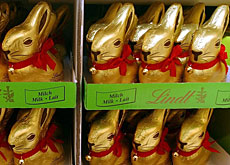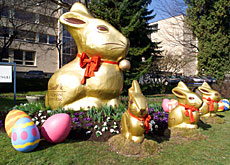Easter bunny’s ancestor in peril

Life for the endangered brown hare, the symbolic ancestor of the Easter bunny, is no picnic.
A report says that numbers have been steadily declining in Switzerland and more needs to be done to protect their natural habitat so they do not disappear altogether.
“Life for brown hares is increasingly difficult, especially due to agricultural land use,” a pessimistic Matthias Kestenholz, head of the Swiss Ornithological Institute which monitors endangered species, told swissinfo.
On top of intensive farming practices, brown hares have to cope with new roads and vehicles which criss-cross their natural habitat.
The number of brown hares has decreased rapidly in Switzerland in recent years: a 90 per cent reduction since the 1970s.
Numbers are more or less constant for arable land but have continued to decline in grasslands and meadows. On average, only three hares now hop around a one-square-kilometre area.
Hare paradise?
But a series of projects launched by the Swiss Ornithological Institute have given a glimmer of hope to the Swiss floppy-eared community.
Since 1993 a carrot has been offered to farmers in the form of money from the government if at least seven per cent of their farmland is left fallow and given over to ecological compensation programmes.
Three plots of farmland in canton Geneva, which were “optimised” in this way to help stimulate the numbers of brown hares and rare and endangered bird species, have resulted in significant population increases; up to 19 hares chase each other around every square kilometre of these sites.
“If the ecological compensation programme, supported by the federal government, is carried out with a view to achieving a higher quality of habitat, it can have a positive impact on brown hares and other endangered species in a short space of time,” commented Kestenholz.
But in general the quality of habitat in most parts of the Swiss lowlands is inadequate. The main problem is in the grassland areas, he explained, where people cut the grass every four or five weeks.
As a result, neither hares nor endangered ground-nesting bird species which share their habitat, such as lapwings, quails or song larks, are able to raise their offspring successfully.
“High-intensity agriculture should be reduced, but this is a political matter and very difficult to achieve, as Swiss agricultural policy is very conservative and doesn’t favour ecological ideas in general,” said Kestenholz.
“As 20 per cent of Swiss members of parliament are closely connected to the agricultural industry, they try to avoid all favourable ecological changes in this direction.”
swissinfo, Simon Bradley
The European hare or brown hare is a species of hare native to northern, central and western Europe, and western Asia.
It is larger, longer-eared, and longer-legged than a rabbit. It has a body size of 50-70 cm and a tail length of 7-11 cm. A full-grown adult ranges from 2.5 to 6.5 kg. It can run at speeds of up to 70 km/h.
It is strictly herbivorous. It eats grasses and herbs during summer but changes to feeding on twigs, bark, and the buds of young trees in winter.
Normally shy animals, hares change their behaviour in spring, when they can be seen chasing one another around meadows; this appears to be competition between males to attain dominance.
During this spring frenzy, hares can be seen “boxing” – striking one another with their paws. It is usually a female hitting a male, either to show that she is not quite ready to mate or as a test of his determination.
The Romans believed that all life proceeded from an egg, so the egg came to symbolise birth and rebirth. Christians regarded eggs as the seeds of life and associated them with Jesus’ resurrection.
Rabbits were used in early Easter celebrations to symbolise fertility, especially as they give birth to multiple offspring. Anglo-Saxon mythology says that Ostara, the Anglo-Saxon goddess of fertility and rebirth, changed her pet bird into a rabbit to entertain a group of children, and the rabbit laid brightly coloured eggs for them.
Easter was once celebrated by giving coloured eggs to children and later evolved to hiding them in the grass, where a hare had supposedly laid them. Children referred to this Easter mascot as the “Easter Hare”, which later became known as the “Easter Bunny”.

In compliance with the JTI standards
More: SWI swissinfo.ch certified by the Journalism Trust Initiative



You can find an overview of ongoing debates with our journalists here. Please join us!
If you want to start a conversation about a topic raised in this article or want to report factual errors, email us at english@swissinfo.ch.